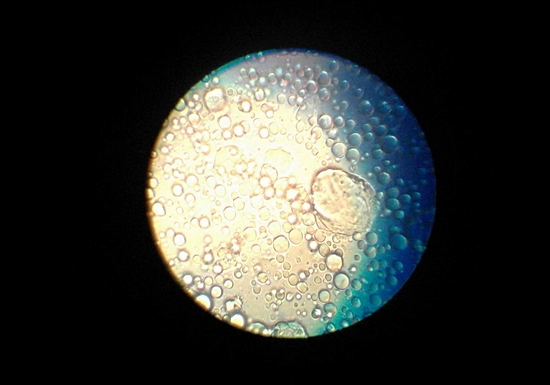
Human breastmilk is an extraordinary liquid, unique and irreplaceable. ‘It’s fascinating. We should definitely get to know more about it’, said Anna Kotlińska from the Faculty of Health Sciences. As part of her PhD research project, she studies the properties of breastmilk.
In the recent years, the number of caesarean sections has been steadily rising. It’s also more common for women to use perinatal antibiotics and feed their babies with formulas. At the same time, allergies, diabetes and asthma are also becoming more common. Because of this, the academic staff of the JU MC Clinic of Obstetrics and Perinatology have begun an investigation into how the method of childbirth and the use of antibiotics affects the composition of women’s milk.
The best there is
Mammary glands start producing milk about 13 weeks into pregnancy. Each droplet contains over 300 ingredients tailored to the child’s needs. The first milk (also known as colostrum) is generated in the late stage of the pregnancy and, when observed under a microscope, has a golden colour. This causes it to have yet another name: liquid gold. The milk’s composition, adaptability and nutritional value is extraordinary: 100 millilitres contain 70 calories, 90 grams of water, 7.4 grams of sugars, 4.2 grams of fats and 1.3 grams of protein. Breastmilk is also the first and fully natural vaccine.

‘Woman provides what’s best for her child straight from her own body. Mothers are doctors, pharmacists and nurses, all at once. Even before the baby gets sick, its mother’s organism already produces medicine which travels to its system through milk’, said Anna Kotlińska.
Of all mammals, humans have the sweetest milk. As said before, 100 grams of milk contain 7 grams of sugars (mostly lactose). In comparison, this value is 1.8 grams for rabbits, 0.5 for polar bears, and 4.5 for goats and Jersey cattle. Breastmilk also contains blood cells and stem cells as well as antibodies (IgA, IgG, IgM, IgE – immunoglobulins that protect us from diseases), hormones, growth factor, cytokines, vitamins, micro- and macro-elements – and many more.
Newcomers
‘For many years, we thought that breastmilk is so good for babies because it’s sterile. We couldn’t be further from the truth! Natural breastmilk is full of bacteria essential for proper development. The infant encounters the first bacteria during childbirth. After that, they get into the baby’s organism through skin contact and mother’s milk’, said Anna Kotlińska.
Human breastmilk contains over 200 types of oligosaccharides. These complex sugars, composed of typically two to ten simple sugars, are very unique. They are produced by female mammary glands. They’re not digested by the infant, since they are intended for beneficial microorganisms, such as Bifidobacterium and Lactobacillus, which enter the baby’s digestive system along with the milk. Thanks to oligosaccharides, these ‘newcomers’ may survive in the child’s body and protect it from harmful bacteria, viruses, and fungi. Natural childbirth, skin contact right after it and breastfeeding are crucial for any baby’s well-being.
What if we administer antibiotics?
‘But what’s responsible for these wonderful properties of breastmilk? Can they be changes and, if so, how? We want to know the answers to these question so we may help women care for their children’, added Anna Kotlińska.
There are several factors which contribute to changes in the bacterial flora of breastmilk, such as mother’s autoimmunological diseases, her diet, antibiotic therapy, type of childbirth, and stage of lactation. The number of caesarean sections has increased in the recent years. Does that affect the bacterial flora in various places of the child’s organism (‘microbiomes’)? Research (e.g. Influence of Intrapartum Antibiotic Prophylaxis for Group B Streptococcus on Gut Microbiota in the First Month of Life) shows that suggests that this is indeed the case. Scientists have observed lower levels of probiotic bacteria in babies – a direct effect of caesarean sections.

‘At the Clinic of Obstetrics and Perinatology, we collect colostrum samples from two groups of women – those that gave birth naturally and those that were subject to caesarean section. The patients from the latter group give one additional sample taken before the operation, when they’re still pregnant’, explained Anna Kotlińska.
Women in both groups give one 1.5 millilitre sample a day throughout their stay in the hospital. The scientists aim to study 250 colostrum samples taken from 100 patients. In their analyses, they will use innovative molecular method: new generation sequencing (NGS). This will allow them to read sequences, i.e. successive nucleotides in a DNA molecule.
An analysis of the microbiological composition of colostrum in the perinatal period will prove useful in identifying the species of bacteria present both before and after the birth. ‘We’re studying breastmilk before and after the birth. We check if there are any changes in the biological diversity of bacteria caused by antibiotics administered during the caesarean section. We then compare this to the results from women that have given a natural birth’, said Anna Kotlińska.
The research project began in 2015. The scientists are still collecting samples. ‘If our analyses prove that antibiotics change the bacterial flora of babies’ organisms, it will surely result in new medical regulations and recommendations. For instance, it may become advisable to store some colostrum for new-borns before performing a caesarean section. Future parents and medical staff will have some studying to do,’ stated Anna Kotlińska.
Original text: www.nauka.uj.edu.pl





